It’s hard to beat the lovely patina of aged wood. It brings warmth, texture and character to the home landscape. Used in the garden, reclaimed wood from historic structures brings history and charm to your planting beds, borders, outdoor furniture and fences. Read on to learn about using salvaged wood in DIY and professional projects.
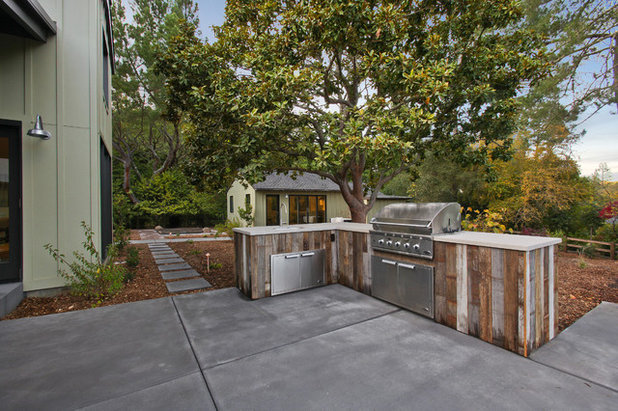
Hughes Construction, Inc
The basics. Reclaimed wood is recycled lumber that most likely came from demolished buildings, such as warehouses, barns or factories. Many of these older buildings are filled with harmful materials (like lead paint and asbestos), so it’s important to know how the reclaimed wood has been sourced.
The best reclaimed wood (strong, dry and free from asbestos or lead paint) is sent to various flooring and furniture manufacturers to be integrated into their products, but you can get your hands on smaller quantities of salvaged wood for garden projects. The advantage to using reclaimed wood in the garden is that the wood is fully dry and seasoned, giving it durability and strength.

Earthwork Landscape Architects
Cost. Reclaimed wood’s cost depends on where you are getting it and whether it is raw or already prepped. There can be free sources — for example, when someone is tearing down an old barn or fence and glad to give the material away. Reclaimed wood bought from an architectural salvage or reclaimed-wood supplier will vary in cost depending on the type of wood and the quantity desired.
Reclaimed wood from old-growth forests is also called antique wood. It is among the most expensive reclaimed wood because of its superior quality and strength.
Shown: Old wood from a found cart has been repurposed as a garden gate in New Zealand. The handle is made from a horseshoe.
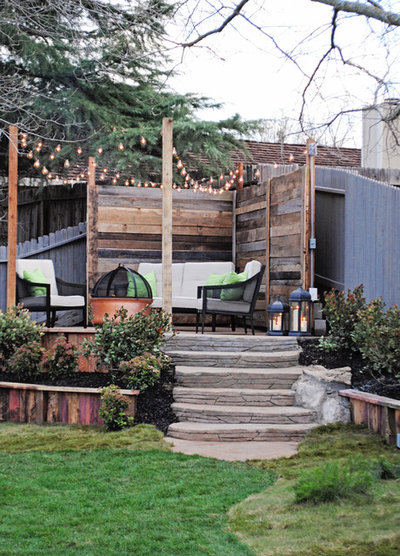
Design by Misha
How to source reclaimed wood. Reclaimed wood abounds if you know where to look. Try these ideas for places to find it:
- Architectural salvage shops, which can be particularly good for finding intact useful items like reusable doors and old barrels
- Specialty lumber yards that prep and dry reclaimed wood for resale to the public
- Barns that are being torn down
- Wood shipping crates and barrels from wineries, breweries or olive oil companies
Shown: Reclaimed lumber forms a wood panel backdrop in this Sacramento-area backyard.
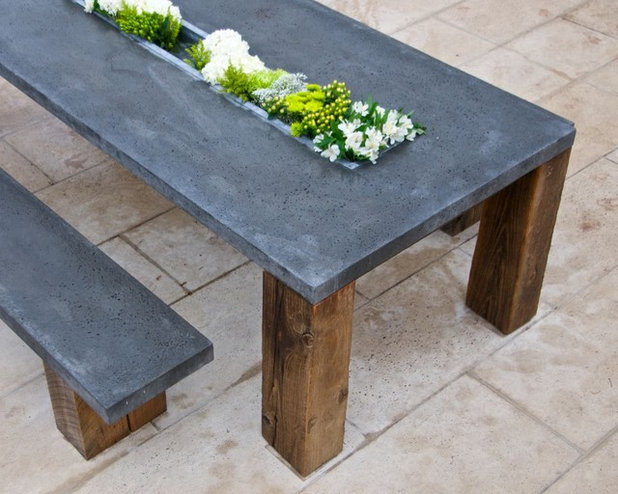
Maynard Studios
Tips for finding professionals who work with reclaimed wood. Furniture makers and designers often incorporate reclaimed wood into their work precisely because it has a charm and texture that aren’t found in new lumber. Experienced carpenters will know how to find and use reclaimed wood as well. Look for professionals who have reclaimed-wood products and projects in their portfolios and search for those who boast eco-practices, sustainable woodworking and working with salvaged wood.
Professional suppliers who reclaim wood as their specialty practice will source the wood, clean it, dry it in a kiln, then remill the pieces to make them straight. That is more common for interior and architectural projects. For the garden, you may want to keep the wood as it is.
Browse reclaimed wood professionals on Houzz
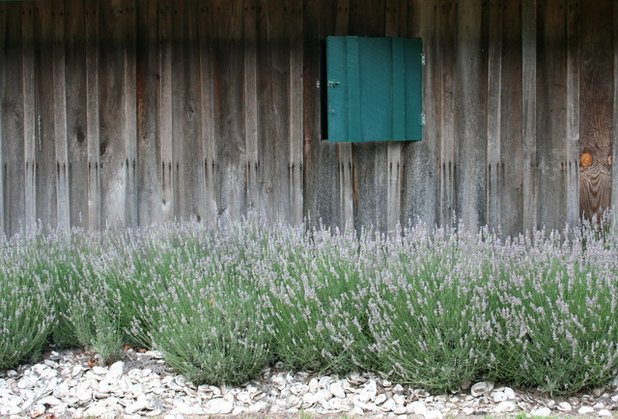
Gardening with Confidence®
Tips for DIY wood reclamation. Reusing materials carries some risks, and with wood, there are likely to be nails, screws or metal staples hiding in the timbers. Use a handheld metal detector, the kind with a long, flat paddle, to sweep over the wood and locate nails and other pieces of metal. Remove each one. You don’t want to run into any metal when you’re sawing or working with the wood.
Be cautious about where you source the wood. Materials from old structures could have lead paint or asbestos residue. Ask your source about this before hauling home your trash-to-treasure. Don’t mess with lingering chemicals. It’s too risky and requires lots of safety gear and a professional working environment. It’s a good idea, regardless, to wear a safety mask to protect yourself from inhaling any particles when working with reclaimed wood.
For outdoor use, the prep work can be minimal — the wood might simply need a surface cleaning with a wire brush.
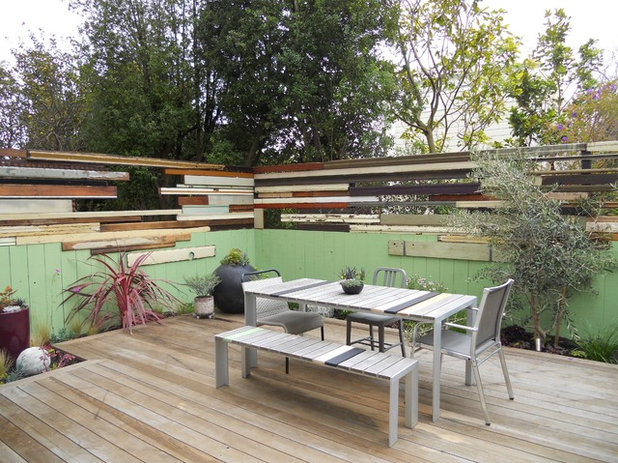
Growsgreen Landscape Design
What makes it sustainable. Reclaimed wood falls under the reduce, reuse, recycle mantra. You are essentially giving a second life to a material that would otherwise be sent to the trash. By using reclaimed material, you also are not purchasing newly cut trees.
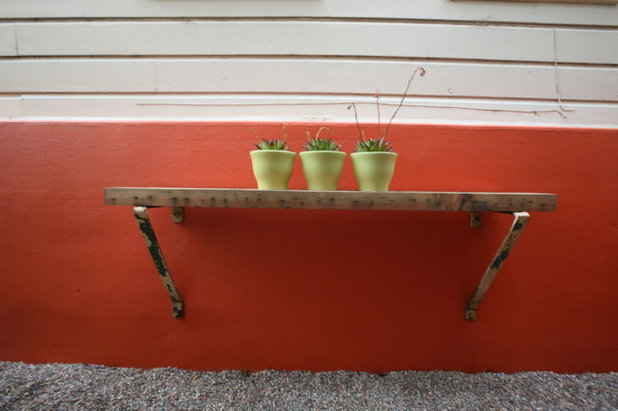
Boor Bridges Architecture
Design Inspiration for Reclaimed WoodOutdoor shelf. This sweet shelf is made from one piece of reclaimed wood and mounted to the side of a house. Notice the perfectly straight top, which means it was probably remilled to have a non-warped shape.
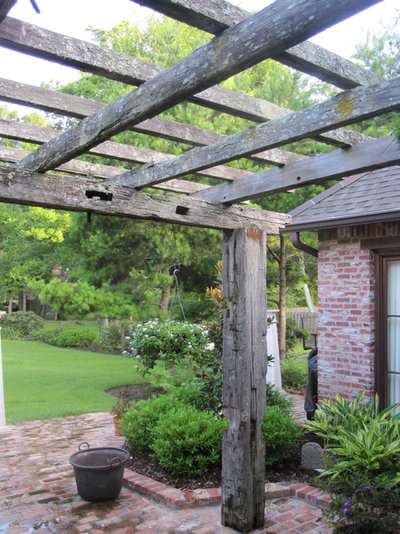
Reclaimed DesignWorks
Timber frame. This reclaimed-wood pergola sets off the concrete patio from the landscape beyond. The wood shows its age through a beautiful texture and light-gray patina.
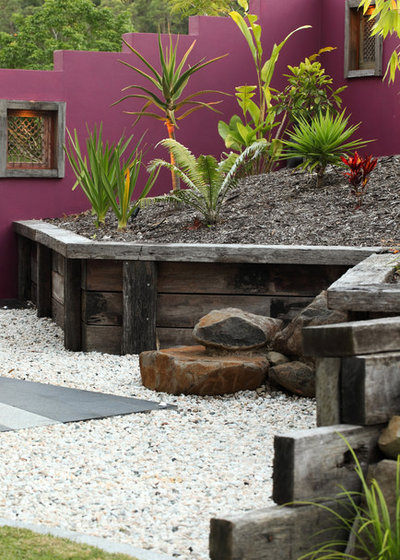
Living Style Landscapes
Rustic retaining walls. This is a standard, simple wooden retaining wall design for a raised planting area in the garden. Wooden uprights are driven into the ground at a depth equal to the height above the ground. Wood timbers are stacked to create the wall, which is topped with another piece of lumber.

gytis
Planting bed edging. Low succulents and rock mulch fit beautifully with aged timber. Turned upright, the timbers make a tall back edging that mixes with larger stones. Laid along the ground, the timbers create just enough of an edge between the planted area and the gravel walkway.
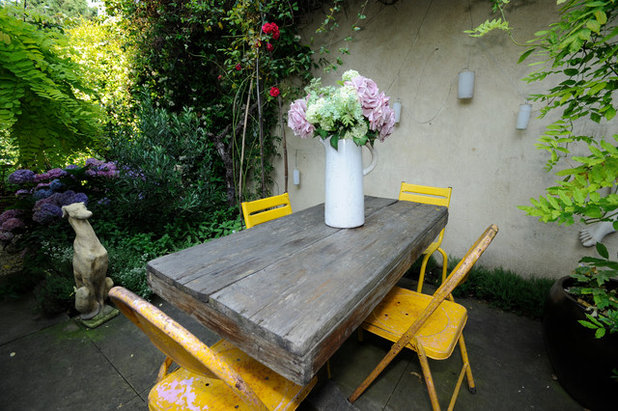
Beccy Smart Photography
Outdoor furniture. This little patio table is made from reclaimed lumber. The aged wood’s gray tones nicely offset the mustard-yellow folding chairs.
Browse more landscape design ideas on Houzz





